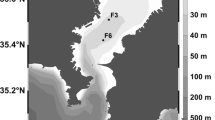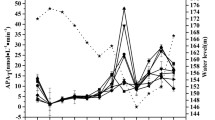Abstract
We investigated the seasonal variability of free alkaline phosphatase activity in seawater and alkaline phosphatase hydrolysable phosphorus (APHP) at 3 stations in Hiroshima Bay using alkaline phosphatase extracted from the dinoflagellates Alexandrium tamarense and Gymnodinium catenatum. The dissolved inorganic phosphorus (DIP) was lower than 1 µM in all samples; the lowest values were in May. The amount of APHP was high at the surface and bottom waters of all stations in May, showing DIP-depleted conditions. In August and November, the amount of APHP was much less than the amount of APHP in May, indicating that the availability of dissolved organic phosphorus (DOP) for these species was low and/or uptake during the dinoflagellate blooming might have occurred in the area. The results obtained from short-term variations of AP activity might suggest that the growth of dinoflagellates in this season may be partly supported by the AP produced by other diatoms.
Similar content being viewed by others
References
Boni, L., E. Carpene, D. Wynne, and M. Reti. 1989. Alkaline phosphatase activity inProtogonyaulax tamarensis.J. Plankton. Res.,11, 879–885.
Cembella, A.D., N.J. Antia, and P.J. Harrison. 1984. The utilization of inorganic and organic phosphorus compounds as nutrients by eukaryotic microalgae: A multidisciplinary perspective: Part 1. CRC Critic.Rev. Microbiol.,10, 317–391.
Chróst, R.J. 1991. Microbial enzymes in aquatic environments. Springer-Verlag, New York. 317 p.
Gonzàlez-Gil, S., B. A. Keafer, R.V.M. Jovine, A. Aguilera, S. Lu, and D.M. Anderson. 1998. Detection and quantification of alkaline phosphatase in single cells of phosphorus-starved marine phytoplankton.Mar. Ecol. Prog. Ser.,164, 21–35.
Guillard, R.R.L. and P.E. Hargraves. 1993. Stichochrysis immobilis is a diatom, not a chrysophyte.Phycologia,32, 234–236.
Hallegraeff, G.M., S.O. Stanley, C.J. Bolch. and S.I. Blackburn. 1989. Gymnodinium catenatum blooms and shellfish toxicity in southern Tasmania, Australia. p. 77–80. In:Red tides. ed. by T. Okaichi, D.M. Anderson, and T. Nemoto. Elsevier, New Yo r k.
Hernàndez, I. and B.A. Whitton. 1996. Retention of P-nitrophenol and 4-methylumbelliferone by marine macroalgae and implications for measurement of alkaline phosphatase activity.J. Phycol.,32, 819–825.
Hiroshima Prefecture. 1995. Report to observation of shellfish poisoning, 1994. Hiroshima, 1–5. (In Japanese)
Holm-Hansen, O.C., C.J. Lorenzen, R.W. Holms, and J.D.H. Strickland. 1965. Fluorometric determination of chlorophyll.J. Cons. Perm. Int. Explor. Mer.,30, 3–15.
Keller, M.D., R.C. Selvin, W. Claus, and R.R.L. Guillard. 1987. Media for the culture of oceanic ultraphytoplankton.J. Phycol.,23, 633–638.
Koroleff, F. 1983. Determination of phosphorus. P. 172. In:Methods of seawater analysis. ed. by K. Grasshoff, M. Ehrhardt, and K. Kremling. Verlag Chemie, Weinheim.
Kuenzler, E.J. and J.P. Perras. 1965. Phosphatases of marine algae.Bull. Mar. Biol. Lab.,128, 271–284.
Kuenzler, E.J. 1965. Glucose-6-phosphate utilization by marine algae.J. Phycol.,1, 156–164.
Maeda, M. and N. Taga. 1973. Deoxyribonuclease activity in seawater and sediment.Mar. Biol.,20, 58–63.
Nausch, M. 1998. Alkaline phosphatase activities and the relationship to inorganic phosphate in the Pomeranian Bight (southern Baltic Sea).Aquat. Microb. Ecol.,16, 87–94.
Oh, S.J., T. Yamamoto, Y. Kataoka, O. Matsuda, Y. Matsuyama, and Y. Kotani. 2002. Utilization of dissolved organic phosphorus by the two toxic dinoflagellates, Alexandrium tamarense and Gymnodinium catenatum (Dinophyceae).Fisheries Sci.,68, 416–424.
Oh, S.J. and Y.H. Yoon. 2004. Effects of water temperature, salinity and irradiance on the growth of the toxic dinoflagellate,Gymnodinium catenatum (Graham) isolated from Yeosuhae Bay, Korea.Algae.,19, 1–10. (In Korean)
Parsons, T.R., M. Takahashi, and B. Margrave. 1984. Biological oceanographic processes. Pergamon Press. 330 p.
Pollehne, F., S. Busch, G. Jost, B. Meyer-Harms, M. Nausch, M. Reckermann, P. Schäning, D. Setzkorn, N. Wasmund, and Z. Witek. 1995. Primary production patterns and heterotrophic use of organic material in the Pomeranian Bay (Southern Baltic).Bull. Sea. Fish Inst.,3, 43–60.
SECA (Seto Inland Sea Environmental Conservation Association). 1998. Seto Inland Sea Environmental Conservation, Kobe. 1–17. (In Japanese)
Strickland, J.D.H. and T.R. Parsons. 1972. A practical handbook of seawater analysis. Fishries Research Board of Canada, Ottawa. 310 p.
Suzumura, M., K. Ishikawa, and H. Ogawa. 1998. Characterization of dissolved organic phosphorus in coastal seawater using ultrafiltration and phosphohydrolytic enzymes.Limnol. Oceanogr.,43, 1553–1564.
Tada, K., K. Monaka, M. Morishita, and T. Hashimoto. 1998. Standing stocks and production rates of phytoplankton and abundance of bacteria in the Seto Inland Sea,Japan. J. Oceanogr.,54, 285–295.
Uchida, T. 1992. Alkaline phosphatase and nitrate reductase activity inProrocentrum micans Ehrenberg.Bull. Plankton Soc. Jpn.,38, 85–92.
Valiela, I. 1995. Marine Ecological Processes. Springer-Verlag, New York. 686 p.
Yamaguchi, M. and S. Itakura. 1999. Nutrition and growth kinetics in nitrogen- or phosphorus-limited cultures of the noxious red tide dinoflagellateGymnodinium mikimotoi.Fisheries Sci.,65, 367–373.
Yamamoto, T. and K. Tarutani. 1997. Effects of temperature, salinity and irradiance on the growth of toxic dinoflagellate Alexandrium tamarense isolated from Hiroshima Bay, Japan.Jpn. J. Phycol. (Sorui),45, 95–101. (In Japanese)
Yamamoto, T., M. Ishida, and T. Seiki. 2002a. Long-term variation in phosphorus and nitrogen concentration in the Ohta River water, Hiroshima, Japan as a major factor causing the change in phytoplankton species composition.Bull. Jpn. Soc. Fish. Oceanogr.,66, 102–109. (In Japanese)
Yamamoto, T., S.J. Oh, and Y. Kataoka. 2002b. Effect of temperature, salinity and irradiance on the growth of the toxic dinoflagellateGymnodinium catenatum (Dinophyceae) isolated from Hiroshima Bay, Japan.Fisheries Sci.,68, 356–363.
Author information
Authors and Affiliations
Corresponding author
Rights and permissions
About this article
Cite this article
Oh, S.J., Yoon, Y.H., Yamamoto, T. et al. Alkaline phosphatase activity and phosphatase hydrolyzable phosphorus for phytoplankton in hiroshima bay, Japan. Ocean Sci. J. 40, 183–190 (2005). https://doi.org/10.1007/BF03023517
Received:
Revised:
Accepted:
Issue Date:
DOI: https://doi.org/10.1007/BF03023517




